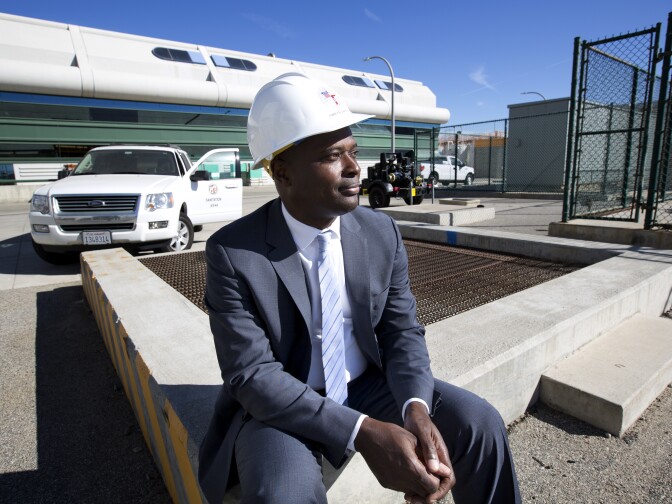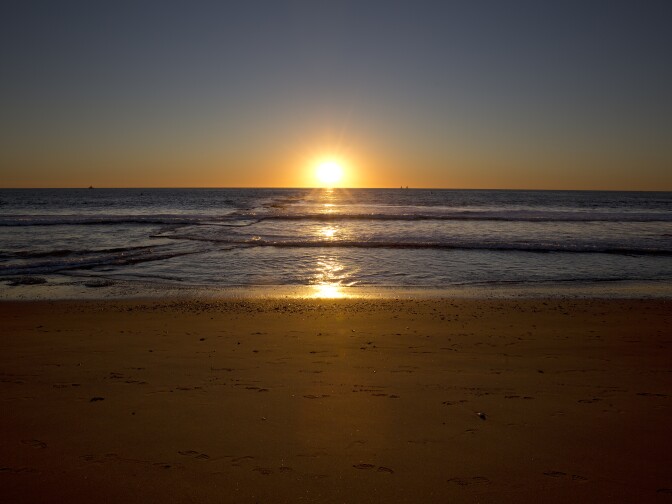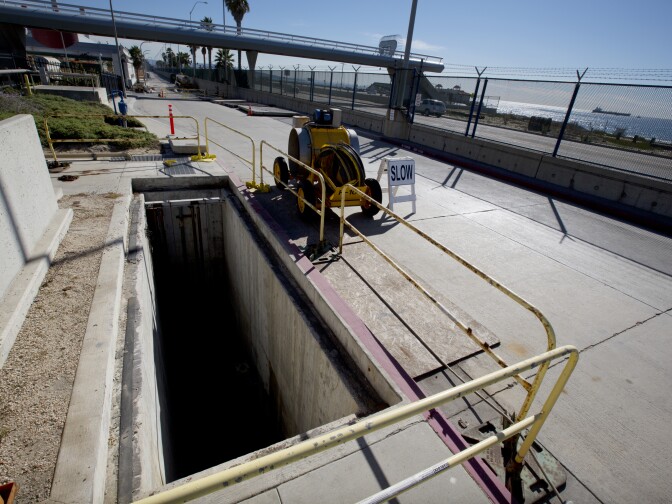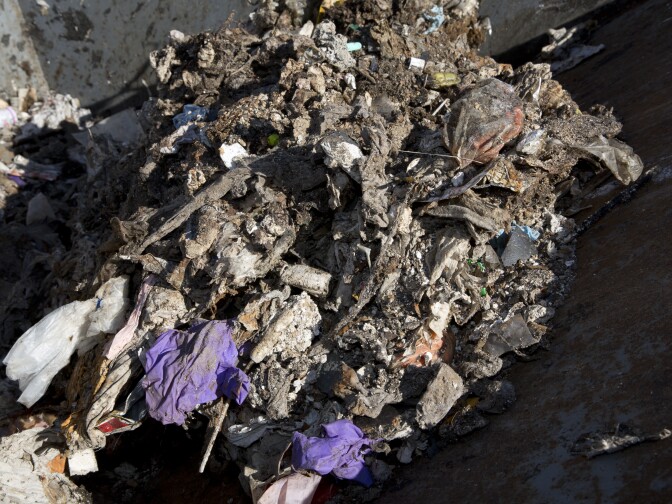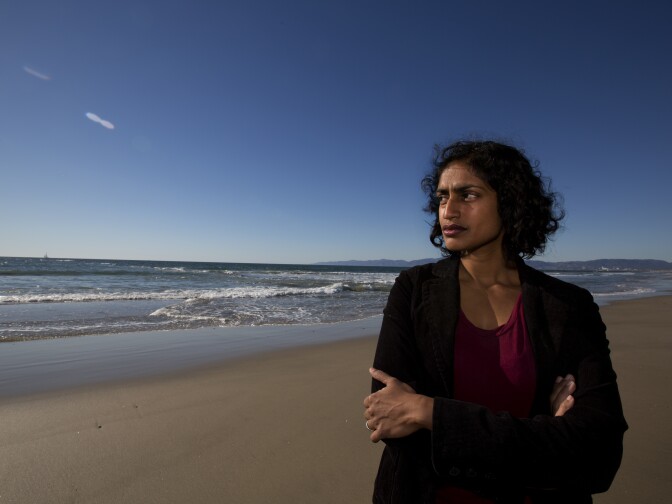With our free press under threat and federal funding for public media gone, your support matters more than ever. Help keep the LAist newsroom strong, become a monthly member or increase your support today.
Sewer plant hid syringes and other waste for years before Dockweiler Beach spill
Tons of waste, including medical and personal hygiene items that were flushed down Los Angeles toilets, lurked undetected in a sewer plant storm drain for 10 years until it washed up on Dockweiler Beach in mid-September, plant officials say in a new report on the spill.
City Sanitation Department officials offer up that scenario in a report to be reviewed Wednesday by the City Council's Energy and Environment Committee. Councilman Mike Bonin, whose district includes the Hyperion Water Reclamation Plant, requested the report.
The spill contained used condoms, tampon applicators and plastic syringes. Authorities closed the beach for several days during the cleanup. The state's Regional Water Quality Control Board is investigating the release of the material from the largest of 14 major wastewater treatment plants in its jurisdiction.
When a sewer line collapsed outside the plant, a flood of raw sewage flowed into the plant and entered the plant's storm drain in 2005, said Tim Dafeta, general manager of the Hyperion plant.
The pumps that would normally run stormwater entering the plant through treatment were not designed to take in the solids found in the raw sewage. The sewage included plastic items like the syringes and personal hygiene waste, he said.
On Sept. 15, heavy rain overwhelmed the sewage plant's primary outlet pipe for putting treated sewage water five miles out to sea. Two of the five-mile pipe's valves were out of service — and began backflowing treated sewage into the plant.
Dafeta said workers routed the treated sewage to the plant's backup pipe — an old one-mile version which had not been used much since the 2005 sewage spill. The storm drain containing the medical and hygiene waste stuck in it drains to the one-mile pipe, and some of it went out to the ocean. The one-mile pipe was open for about five hours that day.
A second sewage release occurred a week later, on Sept. 21. During a long-planned project to replace the five-mile pipeline's valves and pumps, the one-mile pipe was again put into use — carrying millions of gallons of treated sewer water out to sea each day.
As part of the switchover work, a pipeline carrying brine from another water treatment plant (run by West Basin Municipal Water District) was connected to the contaminated storm drain. Again, more of the waste material was flushed down the one-mile pipe. But this time it was piling up on shore.
Under normal circumstances, a mesh at the ocean end of the one-mile pipe would have held the material inside, but photographs taken of the pipe's mouth 50 feet underwater showed the mesh was ripped and out of position.
Surfers were the first to notice the resulting pollution. Zan Sacker surfs daily at Dockweiler Beach with friends who position their boards directly above the large square pipe known as the Hyperion Outfall. It's shape near the surface of the water acts like a reef, or surf break, creating unusual waves to surf.
"I was out there surfing out there on that day that it dumped, I was swimming and it was disgusting," said Sacker, who sells real estate in West L.A. "I was here and I saw tampon applicators, um, a lot of trash, just disgusting — toilet paper and things like that."
It took a few days of closure for the beach to be cleaned. Sacker said he spoke with some of the workers.
"I asked one of them what kind of stuff have you seen, and he's like, 'I just saw a couple of needles the other day.' So those are the things that scare me most, stepping on a rogue needle," Sacker said.
Dafeta said it took a while for his workers to understand where the waste came from that showed up beginning on Sept. 21 and 22.
"All our processes were functioning fine, so when we got the information on the 22nd about debris floating on the beach, that was basically strange to us, because everything was fine internally inside the plant," Dafeta said. "So then, that made us begin to look at, OK, where could this possibly come from?"
The Hyperion Water Reclamation Plant is 144 acres — a bit larger than Disneyland, Dafeta said. He's run the plant for about two years and had worked there in the late 1980s.
It's a vast complex of pipes, skimmers and settling pools — all designed to separate liquid from solid. Hundreds of millions of gallons of liquid gets put out to sea each day through the Hyperion Outfall.
An El Niño winter bringing big rains would not result in another similar sewage spill as at Dockweiler Beach, Dafeta said, insisting the September spills were a one-time occurrence. Since then, all five pumps and valves that keep the primary five-mile pipe working have been replaced, and the storm drain harboring decade-old waste has been flushed out.
Rita Kampalath, science and policy director from Heal the Bay, said her agency still had questions about the spill. Heal the Bay has advocated for improving the quality of the wastewater the Hyperion plant puts into the ocean for decades, and it tends to play a watchdog role.
Kampalath questions how the tons of debris that washed up on the beach could have come from the 2005 sewage spill.
"It was still a tremendous amount of material, and for that to go sort of undiscovered and uncleaned for over 10 years, it still leads to some questions," she said.
The California Regional Water Quality Control Board has ordered the city Sanitation Department to report the causes of the waste spill that violated the city's permit by January, said its executive officer, Sam Unger.
The Hyperion sewage discharge raises a bigger issue for the region in trying to make sure wastewater plants are not deteriorating, Unger said.
"These plants are old and they need to be maintained in a way that minimizes these kinds of discharges," Unger said.
The board oversees those 14 major wastewater treatment plants, including two — Los Angeles city's Hyperion plant and an L.A. County plant — that discharge waste to the ocean. The others send treated wastewater to inland rivers or underground. Many other smaller plants are run by cities and water agencies.
"Clearly the type of discharge that occurred in September is a violation of the permit that we issued," Unger said. "It's the board's intent to have a full understanding of the steps that need to be taken and that the city implement those steps so that maintenance activities can proceed without these discharges that violate the permit."
Unger said the actual cause of the Hyperion spill "is still unknown and we are still trying to get to the bottom of it."
He said he would make a report to the board Dec. 10 about the progress of the spill investigation.
The regional board is working with the state water resources control board and U.S. Environmental Protection Agency, as well as the city's independent consultants, "so we can get a definitive explanation of how this discharge, which should not have occurred, did occur," Unger said.




